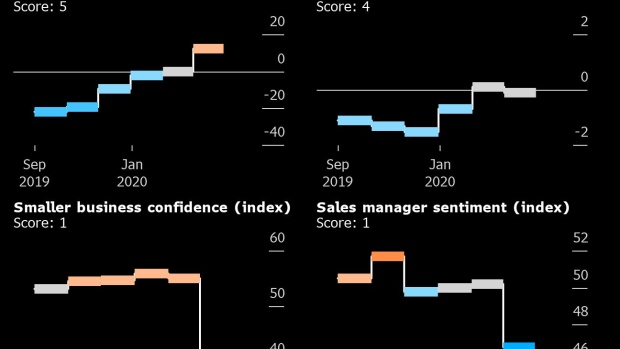Feb 25, 2020
Virus Damage to China’s Economy Clear From Early Indicators
, Bloomberg News

(Bloomberg) -- Terms of Trade is a daily newsletter that untangles a world threatened by trade wars. Sign up here.
A range of early indicators of China’s economy in February confirm that the coronavirus outbreak has crippled production and consumption, as factories remain below capacity and transport is curtailed.
Five of the eight indicators tracked by Bloomberg dropped in February from January, with two indicators of business confidence plunging to the lowest on record.
The improvement in the headline South Korea exports in first 20 days of the month hides a drop in shipments to China and was flattered by the distortions from the Lunar New Year. Expectations of fresh stimulus have also kept financial markets more buoyant than real activity would suggest.
While businesses are restarting and the official data shows the rise in infections slowing, the virus is not yet overcome, and companies and various levels of governments have to weigh the desire to return to normality quickly with the need to stop the disease. The economy is forecast to grow the slowest since 1990 according to the median of recent economists’ reports, with Goldman Sachs Group Inc estimating it will expand only 2.5% in this quarter, before rebounding later.
The Data Show China Is Still Struggling to Get Back to Work
A slowdown of that magnitude could lead to higher unemployment, bad loans, and bankruptcies. Already car sales are plummeting and property developers are being squeezed as people hold back on spending as they wait to see what will happen with the disease, and when they can go back to work.
The reaction to the outbreak will be visible in the first official statistics for February -- the Purchasing Manager Indexes due on Feb. 29. The indicator for manufacturing is forecast to drop to the lowest since the global financial crisis, although five economists are forecasting it to be even worse than that.
“The earliest business surveys have already shown record declines of demand and output. The overall momentum reversed strength in previous months to weakness in February, as the virus hit industrial production, supply chains and consumption,” according to Bloomberg Economics’ Qian Wan. “We expect activity to start to recover from March. Efforts to contain the virus continue, but the government is clearly shifting” toward pro-growth policies to and help companies get back to work after the extended Lunar New Year break, she said.
A monthly survey on the health of China’s small and medium-sized businesses plummeted to a record-low in February, highlighting the negative economic impact of the outbreak. A sub-index from the survey by Standard Chartered Plc evaluating “current performance” dropped even more sharply, while the reading for the outlook was better than the headline number, signaling some hope for recovery once the outbreak is contained.
About two-thirds of small- and medium-sized companies only have enough cash on hand to survive for up to three months, according to the report from Shen Lan and Ding Shuang at Standard Chartered. Earnings in the first quarter will fall 43%, according to their survey, with the biggest drops in wholesale and retail industries.
One bright spot in the indicators Bloomberg tracks has been Chinese stocks, which took just weeks to recover from a record sell-off earlier this month triggered by the virus. But that almost 10% rally since Feb. 3 is built on little more than liquidity, surging partly on hopes that monetary easing and fiscal support measures would help companies weather economic headwinds. Leverage on Chinese exchanges rose above 1 trillion yuan ($143 billion), the highest since early 2016.
Cracks Appear in China’s Most Leveraged Stock Market Since 2016
Note on Early Indicator construction
Bloomberg Economics generates the overall activity reading by aggregating the three-month weighted average of the monthly changes of eight indicators, which are based on business surveys or market prices.
- Major onshore stocks - CSI 300 index of A-share stocks listed in Shanghai or Shenzhen
- Key property stocks - All the constituents of CSI 300 Index that are in the real-estate industry
- Iron ore prices - Spot price of iron ore for shipment to Qingdao port (dollar/metric tonne)
- Copper prices - Spot price for refined copper in Shanghai market (yuan/metric tonne)
- South Korean exports - South Korean exports in the first 20 days of each month
- Factory inflation tracker - Bloomberg Economics created tracker for Chinese producer prices
- Small and medium-sized business confidence - Survey of companies conducted by Standard Chartered Bank
- Sales manager sentiment - Survey of sales managers in Chinese companies by World Economics Ltd.
To contact Bloomberg News staff for this story: James Mayger in Beijing at jmayger@bloomberg.net
To contact the editor responsible for this story: Jeffrey Black at jblack25@bloomberg.net
©2020 Bloomberg L.P.


